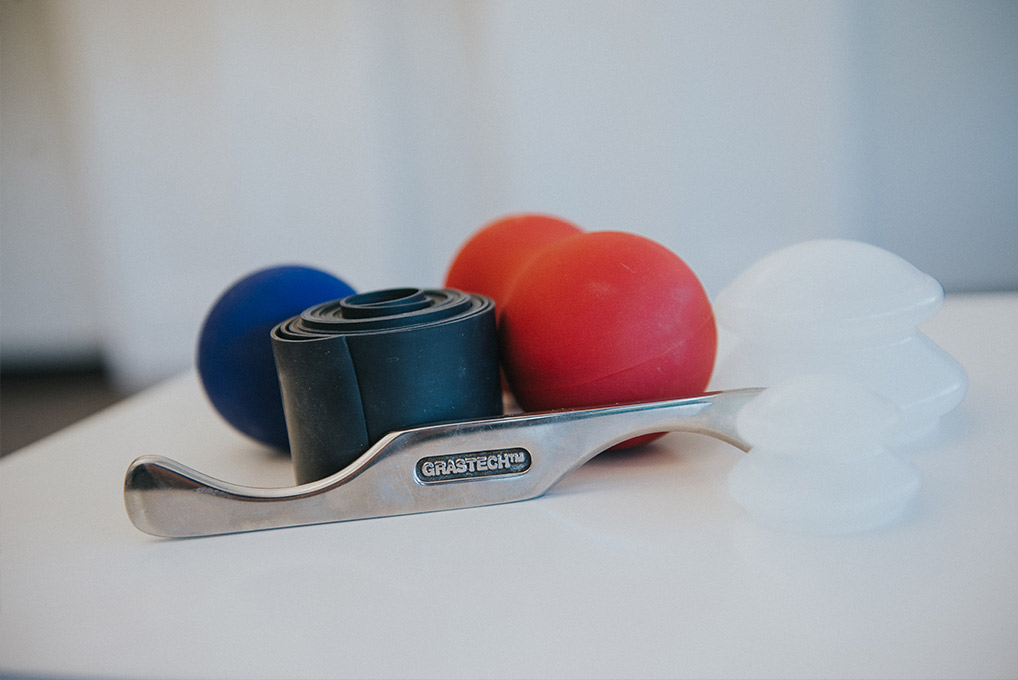
Graston Technique®
Graston Technique® is an innovative, patented form of instrument-assisted soft tissue mobilization that enables clinicians to effectively break down scar tissue and fascial restrictions. The technique utilizes specially designed stainless steel instruments to specifically detect and effectively treat areas exhibiting soft tissue fibrosis or chronic inflammation.
Originally developed by athletes, Graston Technique® is an interdisciplinary treatment used by more than 15,000 clinicians worldwide – including physical and occupational therapists, Massage therapists, chiropractors, and athletic trainers.
The Technique:
- Separates and breaks down collagen cross-links, and splays and stretches connective tissue and muscle fibers
- Increases skin temperature
- Facilitates reflex changes in the chronic muscle holding pattern
- Alters spinal reflux activity (facilitated segment)
- Increases the rate and amount of blood flow to and from the area
- Increases cellular activity in the region, including fibroblasts and mast cells
- Increases histamine response secondary to mast cell activity
Why Is Scar Tissue A Problem?
Scar tissue limits range of motion, and in many instances causes pain, which prevents the patient from functioning as he or she did before the injury.
How Is Scar Tissue Different From Other Tissue?
When viewed under a microscope, normal tissue can take a couple of different fashions: dense, regular elongated fibers running in the same direction, such as tendons and ligaments; or dense, irregular and loose with fibers running in multiple directions. In either instance, when tissue is damaged it will heal in a haphazard pattern–or scarring–that results in a restricted range of motion and, very often, pain.
How Are The Instruments Used?
The Graston Technique® instruments are used to enhance the clinician’s ability to detect adhesions, scar tissue or restrictions in the affected areas. Skilled clinicians use the stainless steel instruments to comb over and “catch” on fibrotic tissue, which immediately identifies the areas of restriction. Once the tissue has been identified, the instruments are used to break up the scar tissue so it can be absorbed by the body.
Is The Treatment Painful?
It is common to experience minor discomfort during the procedure and some bruising afterwards. This is a normal response and part of the healing process.
Is Graston Technique® Used Alone?
No. Whether the injury is work or non-work related, the Graston Technique® Protocol is the same. Our protocol includes a brief warm-up exercise, Graston Technique® treatment, followed by stretching, strengthening and ice.
What Is The Frequency Of Treatment?
Patients usually receive two treatments per week over 4-5 weeks. Most patients have a positive response by the 3rd to 4th treatment.
Are There Any Benefits Of This Treatment?
Yes. Most patients are not disabled and continue to perform their regular functions at home or work. Graston Technique® gives back the control that is often lost when injury strikes.
Is Graston Technique® Something New?
The concept of cross fiber massage is not new. Graston Technique® is grounded in the works of English orthopedist James Cyriax. The use of our specially designed instruments and protocol is new.
Graston Technique® has become standard protocol in universities and hospital-based outpatient facilities, industrial on-site treatment settings such as Indiana University and the University of Michigan. The technique is also being used at industrial settings and by NBA, NHL and Major League Baseball trainers.
What Kinds Of Results Does Graston Technique® Produce?
Historically, the Graston Technique® has resolved 87% or more of all conditions treated. It is equally effective on restoring function to acute and chronic injuries, and pre and post surgical patients.
Can Anyone Obtain The Instruments?
Only clinicians who have been trained and accredited in the Graston Technique® Basic course are qualified to obtain the Graston Technique® instruments and apply the technique to treat patients. The course is offered either on-site or at trainings offered throughout the year at a variety of locations.





